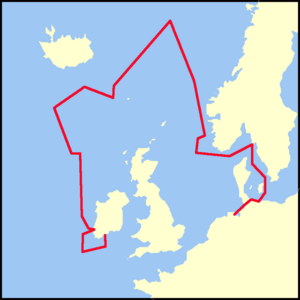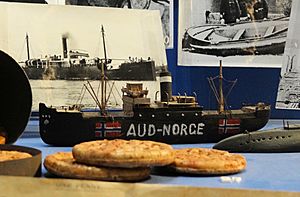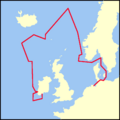SS Libau facts for kids
|
This model shows the ship painted to look like the Aud. It's at the Cork Public Museum.
|
|
Quick facts for kids History |
|
|---|---|
| Name | SS Castro |
| Laid down | 1907 |
| Fate | Captured by Imperial German Navy in 1914 |
| Name | Libau |
| Namesake | Liepāja (Libau), a city in the Baltic region |
| Acquired | 1914 |
| Fate | Sunk by its own crew in 1916 |
| Wreck site: | Off Daunt Rock, Cork 51°43′N 8°14′W / 51.71°N 8.24°W |
| General characteristics | |
| Type | Merchant vessel |
| Tonnage | 1,228 GRT |
| Length | 220 ft (67 m) |
| Beam | 32 ft (9.8 m) |
| Draught | 12 ft (3.7 m) |
| Speed | 10 knots (19 km/h; 12 mph) |
The SS Libau was a German steamship. It was originally called the SS Castro. In 1916, during World War I, the ship was secretly disguised. It pretended to be a Norwegian ship named the SS Aud. The Libau's secret mission was to carry weapons from Germany to Ireland. These weapons were meant to help a rebellion called the Easter Rising.
Contents
The Ship's Story
The SS Castro was a cargo ship built in England in 1907. It weighed 1,062 tons and was 220 feet (67 meters) long. The ship was captured by the German Navy in 1914, at the start of World War I.
The Germans renamed the ship Libau. It stayed unused until 1916. Then, it was chosen for a very important secret mission. The Libau was to carry weapons to Ireland. To hide its true identity, the ship was made to look like a Norwegian vessel. This was part of the plan to support the Easter Rising.
The Secret Mission

On April 9, 1916, the Libau began its journey. It sailed from a German port, pretending to be the Norwegian ship Aud. The ship had a crew of 22 men. They were led by Captain Karl Spindler. Their goal was the southwest coast of Ireland.
The Libau was packed with about 20,000 rifles. It also carried a million rounds of ammunition, 10 machine guns, and explosives. To hide this cargo, it was covered with timber. The ship managed to avoid British patrols. It even survived strong storms near Rockall.
The Libau reached Tralee Bay in Ireland on April 20. The plan was to meet Roger Casement there. He was a former government official who helped arrange the weapons. However, the Libau had no radio. So, the crew did not know that their Irish contacts were told to meet the ship on a different day and place.
On April 21, the British authorities discovered the Libau's true identity. Three British destroyers approached the ship. Captain Spindler tried to escape but was cornered. He allowed his ship to be escorted towards Cork Harbour.
To prevent the weapons from falling into British hands, the German crew sank the ship themselves. Captain Spindler and his crew were held as prisoners for the rest of the war.
Roger Casement had arrived in Ireland by submarine that same day. But he was captured and arrested. He never met the Libau. He was later put on trial for his actions and executed.
Also, one of the cars carrying the Irish contacts crashed into a river. This happened many miles away from the meeting point. So, there was no way for the weapons to be successfully transferred.
Items from the Ship
Rifles Found
Some rifles were saved from the Libau before it sank. You can see examples of these rifles in museums today. They are in places like the Cork Public Museum and the National Museum of Ireland in Dublin. The Imperial War Museum in London also has some.
Many rifles from the Libau are part of an exhibition on Spike Island. This island is near where the ship sank. The Libau's crew were held there for a short time. The exhibition shows the Mosin-Nagant M1891 rifle. This type of rifle was captured by the Germans from Russian forces in World War I.
Even though some called them "old-fashioned," these rifles were actually quite good. They could fire quickly and accurately. They were used by armies even into World War II.
Ship's Anchors
In 2012, a special operation recovered the Libau's anchors. They were found at the wreck site outside Cork Harbour. After being cleaned and preserved, these anchors are now on public display.
Images for kids
-
Approximate route in April 1916, via the Kiel Canal, the Arctic Circle and Rockall.




